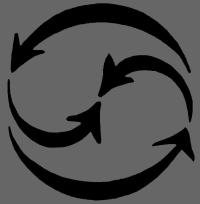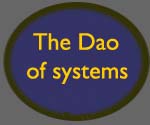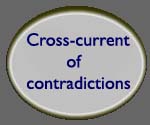What you will find
on this page
This is a broad account of our method - and its dependence upon a natural concordance between the ancient Chinese Dao and modern systems thinking: embedded in such disciplines as cybernetics, neuro-linguistic programming, the Viable Systems Model of Stafford Beer, The Permaculture approach to plant and animal husbandry, and Feldenkrais Method. Our postulate is that the subtle workings of the Dao are actually inherent in our location in the here and now. This is the true "power of now" - and the reason that such seemingly gentle methods can be such effective agents of change.
|
|
Who am I?
|
 |
I am Michael Roth, the author of all
the material on this site. While training as a medical doctor, I was
also an alumnus at the famed AntiUniversity of London (1968-1969), and
became involved with the alternative psychiatry movement in that era
and later.
I worked and studied with the existential psycho-analyst
R.D.Laing, and was a founder-member of the Arbours Association
(London), which provides alternative care for persons diagnosed with
severe mental illness.
My research path has taken me into spheres of
philosophy, social politics, linguistics and anthropology - whilst I
have continued to seek out a genuine way of relating to other human
beings in the troubled milieux of psychiatry, communal living, and
twentieth and twenty-first century social and cultural instability.
I have been consistently inter-disciplinary in all of my
reading and exploration, and the personal and philosophical insights to
which this has given rise are almost always outside the prevailing
classifications - or accepted lists of subjects.
The following authors are they whose work I have been
most deeply occupied with, at different times in my life. This has
often entailed exploring what the actual world feels like, within the
patterns and definitions of life offered by these people. I have also
written extensively, and often critically, about many of them.
Philosophy
- Jean-Paul Sartre
- Martin Buber
- Lao Ze
- St Matthew
- St Mark
- St Luke
- St John
- Rudolf Bultmann
- Paul Ricoeur
- Richard Rorty
- Robert Pirsig
- Donald Davidson
- Jacques Derrida
- Benedetto Croce
- Charles Peirce
- John Dewey
- A.N.Whitehead
- J.H.Randall
- Justus Buchler
- Martha Nussbaum
Biology, Physiology, Ethology and
Cybernetics
Anthropology
- Mary Douglas
- Gregory Bateson
- Milton Ericson
- R.D.Laing
- David Cooper
- Clifford Geertz
- Victor Turner
Virtual Reality
Psychology
- Eugene Gendlin
- Arnold Mindell
- M. Scott Peck
I am the foremost exponent of Charlotte M. Bach's
ground-breaking theories of emergent evolution, described in my A Bolt From the Bleeding Sky
(Dielectric Publications, London, 1984). I continue to work as a
psychiatrist and as a researcher into holistic methods of facilitating
social change. This used to include facilitation and training sponsored by the
organization, Community
Building in Britain which developed and disseminated the
work of the holistic psychiatrist M. Scott Peck through the 90s and noughties.
I am also involved in an exploratory research group
seeking to fuse poetic, practical and fantastical modes of action to
create significant cultural/political interventions in the here and now.
|
|
Our Search for
a Method
Our emerging method comes from
the meeting of ancient practices such as shamanic ecstasy and the
Chinese dao - with the modern disciplines of cybernetics,
neuro-lingistic programming and cultural theory.
The Chinese philosophy of the Dao de Jing is
often treated as obscure and strangely spiritual - but I have always
seen it as being foremost a practical guide to living. This fits in
with the Chinese character for "Dao" - which means all at
once a way, a vision, or a method.
The revolutionary step I have taken, is to place the Dao in the context
of modern systems thinking. The Dao is eloquent about the mysterious
guidance which comes to us from the deeper, hidden realms. From the
point of view of systems theory there is no great mystery - even though
it feels no less wonderful or mysterious in the actual experience of it.
We need to bear in mind: we are a richly complex organism
attuned through millions of lifetimes of co-evolution in a richly
complex environment. And so it is, that the subtle workings of the Dao
are actually resonant within our interior milieu, in the here and now as we are living it out. The
accumulated experience of our entire evolutionary tree is continuously
available and resonates within our cellular organisation, and also in
the spaces between us. (NOTE: these aspects are explored in more detail
in the section of this web-site entitled: biology,
culture, evolution)
The co- presence of living creatures, which means you and me whenever
we meet, brings a complex - in some respects ancient, and bordering on the
eternal - web of forces into play. And so, without denying the
astonishing mystery of ourselves actually being here in the first
place, we can understand the Dao quite prosaically as a method for
seeking a better attunement to the force field we find ourselves in: to
learn to ride more skilfully the eddies and currents that regularly
arise within us, around us and between us.
So it is, that one key aspect of our developing
practice, is that we willingly surrender to the "blooming,
buzzing confusion (1)" in which we live,
move and have our being. We shall explore in detail, in other sections,
what this
means in practice - but we can recognize straightaway that there are
two almost contradictory aspects to the surrender of
which I speak. On the one hand, we inherit at each moment the traces,
patterns
and pressures of the past - which throng about us, hungrily seeking to
embody
themselves in this newly crystallising moment. And on the other hand
each
moment is a re-birth, an opening on to what is new. In this respect it
carries for us the possibility of a new direction, a new point of
departure (2).
We
exist in the cross-current of these twin forces: of repetition, and of
renewal (3). This is what it is like (in
words), to be a species that is suffering the labour-pains
of our own evolutionary process. Our quest, embodied in this
present study, is the cultivation of a new way to
dwell within that cross-current. The method for doing this, depends upon the
interaction of a small number of basic principles which - quite
surprisingly - give rise to a radical new orientation to the flow of
life.
This phenomenon: that a combination of ingredients can bring
about a radically different whole, applies in many different locations,
and in many different ways, within the fabric of our lives. We are so
used to this that - as with other things very familiar to us - it
easily escape our conscious notice entirely. Consider any of our
everyday practices,
for instance: baking a cake, flying a kite, making a cup of tea,
manufacturing
and letting off a firework, or playing a Beethoven symphony. In every
case
there are multiple elements that have to be brought together and
combined in
very precise order, so as to bring about the desired result. Any one of
these
activities would actually appear bizarre or nonsensical, if we did
not already know
the purpose of the whole thing and have a general idea of how it works.
Let us take another example: imagine the components of a jet engine,
displayed
before you for the first time in your life: here is an air inlet, here
a turbo-compressor, a combustion chamber, a fuel inlet, a turbine and a
propulser unit. But what are they doing here? What are they for?
None of the ingredients
makes sense on its own; the whole thing will have to be assembled and
organised, first on the level of understanding and then on the level of
action.
(Actually there are some additional ingredients without which the jet
engine
remains a heap of non-functional metallic sculpture. For instance: a
mathematical theory of propulsion - expressed in precise and complex
equations; and a mechanical theory which includes exhaustive knowledge
of
the properties of the various different materials used in manufacture
and
operation. In addition to all of this we have to presuppose the design
of the
actual aeroplane, which will have the capacity to convert the
propulsive power
of the engine into actual flight through the air.)
In this respect, the Dao of Beginning Again conforms to the same
pattern as any
of the examples given: we have a set of components, (definite
ingredients that
need to be gathered together and prepared within certain limits of
accuracy). And there is also a kind of choreography in how it all gets
put together, so that
each ingredient can perform its proper function within the whole. Thus
our
practical method will emerge as something that anyone can learn how to
do,
given a skilful and empathic teacher.
There is one other key feature that is always entailed in this
situation, in which essential ingredients are combined to generate a
new ensemble with its own unique properties. If only one ingredient is
missing, then the ensemble will fail to function. And in all but the
simplest of these ensembles, if the ingredients are not put together in
the right way then the functioning is going to be noticeably
impaired. These crucial factors become especially important at those
times when we are trying to understand where we have gone wrong - when
things are not functioning as we hoped for, or as we expected.
There are two major factors we had better take
note of, which make this new method significantly different from the
familiar examples we have just been looking at. One is the extremely
flexible and broad-based application of the new
method, which make it appear vague and undefined, in comparison with
baking
a cake or playing a piece of music. We are lacking a tangible product
that will
bring the process to a tidy completion. The Dao of Beginning Again can
be
relevant to all sorts of different situations - and in fact we shall
need to learn
how to deal with a whole array of situations at the same time, if we
want to
make any effective impact on the state of our world). At this point we
shall find
our multiple commitments shading off, one into another, and it will be
easy to
lose the sense of completion and of clear-cut boundaries.
There is an additional factor, which makes this more problematic than
the other
practical tasks I mentioned: that we are inaugurating a new kind
of practice
altogether (though foreshadowed by the Daoist culture-heros (5) of old). So we do
not have generations of cake-makers, kite-fliers or classical musicians
to assure
us that this can be done, and to show us how to do it.
Without an available
body of teachers and role models, our next step has to be delicate and
a little
bit strange.
Now we can proceed with an initial survey of the ingredients of this
prototype
mystery-cake we are going to bake together. After that, an effective
recipe will
be needed - but I have to own up that this is still very much work in
progress. The method is waiting to emerge, as we proceed to combine the
components
into a functioning whole - regretfully I am unable to give a
well-ordered account
in advance of the actual practice of it. In the forthcoming chapters we
are going
to explore various aspects of this new world-view and this will
certainly give
strong pointers to the practice which flows out of it. The actual
development,
however, will depend significantly upon yourself. And for now, we have
the
modest aim of simply surveying the main
ingredients.
NOTES TO THIS SECTION
1. The phrase is William James's (Principles
of Psychology, 1890, p.462) and was intended by him to
characterise the noisy, raw experience that impinges on a baby's
sensibilities. I have commandeered his phrase to symbolise the
busy-ness of nature at large. I
think it is significant that William James - though he regarded
himself primarily as a psychologist - belongs to the one
philosophical tradition which tried to integrate the new biological
theories of evolution into the search for an integrated understanding
about what we are, and what we are doing here. The best overview of
this tradition which I have found, is TEJERA, V.(1966) American
Modern: The Path Not Taken
2. It is well worth
noticing that the "repetition" may be re-vitalising, or deeply
oppressive, and may be felt in either of these modes, too. Likewise,
the "new direction" may be experienced as joyful liberation, as subtly
disturbing, or as horribly disruptive. What is more, the felt
experience may not correspond to the actual consequences - which
themselves may be genuinely liberating, disturbing or disruptive, or a
combination of all three.
3. In this foregoing
section I have tried to
crystallise the deep insights of A.N.Whitehead (Process and
Reality,
Adventures of Ideas) which have the virtue of melding a
sensibility
in tune with mathematical physics and relativity theory, a deep
sympathy with the entire sweep of Western philosophy and powerful
resonances of Jewish mysticism and the Dao. I am not claiming that I
have succeeded, but the same undercurrent hopefully pervades this
entire project.
4. Lao-ze and Juang-ze
probably stand for a
whole cohort of cultural revolutionaries cum problem resolvers who
helped to make ancient China a place that was bearable for human
habitation. Examples from within our own culture might be the
Shakespearian Fool and his mediaeval predecessors; perhaps also
Shakespeare himself. And in other cultures than our own, there are
folk characters such as the Sufi "Nasrudin" and the
Hassidik zadek - who may have performed the same role, of cultural
revolutionary cum problem resolver within their respective cultures.
The ancient Hebrew prophets might also serve, except our tradition
has transmuted these into towering authority figures. In their own
time they would have appeared as misfits, inspired revolutionaries or
madmen. In any case, none of these are on the scene today to guide or
instruct us, and those of our own times who claim to be mystical and
revolutionary teachers offer us little or no clues as to who is, or
is not, the genuine article.
© all content:
copyright reserved, Michael Roth, March 2009
|
|







